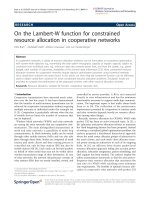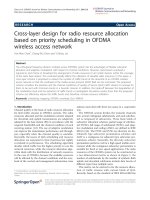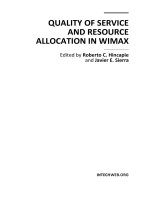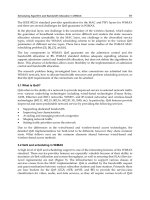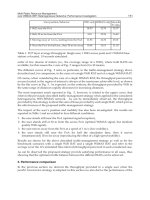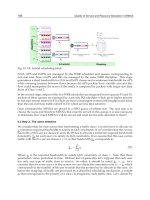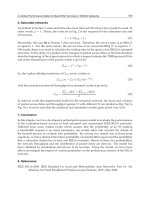Radio resource allocation in wireless OFDM systems
Bạn đang xem bản rút gọn của tài liệu. Xem và tải ngay bản đầy đủ của tài liệu tại đây (3.23 MB, 163 trang )
RADIO RESOURCE ALLOCATION
IN WIRELESS OFDM SYSTEMS
LIANG ZHENYU
NATIONAL UNIVERSITY OF SINGAPORE
2011
RADIO RESOURCE ALLOCATION
IN WIRELESS OFDM SYSTEMS
LIANG ZHENYU
(B.ENG.(Hons.), NTU)
(M.Sc., NUS)
A THESIS SUBMITTED
FOR THE DEGREE OF DOCTOR OF PHILOSOPHY
DEPARTMENT OF ELECTRICAL AND COMPUTER
ENGINEERING
NATIONAL UNIVERSITY OF SINGAPORE
2011
i
Acknowledgements
First and foremost, it gives me great pleasure in acknowledging the guidance and
help of my supervisor, Professor Ko Chi Chung, who has supported me with his
patience and knowledge while allowing me the room to work independently.
I cannot find words to express my gratitude to my co-supervisor, Dr. Chew
Yong Huat, for the advice and insight he has offered. This dissertation would not
have been possible without the guidance, help and valuable assistance of Dr. Chew.
His encouragement, patience and effort have propelled me throughout the course
of research. One simply could not wish for a better or friendlier supervisor.
I am indebted to my wife and parents who have always stood by me and dealt
with all of my absence from many family occasions with a smile.
Finally, this thesis is dedicated to my grandmother who had encouraged and
urged me to pursue my dreams.
ii
Contents
1 Introduction 1
1.1 Orthogonal Frequency Division Multiplexing . . . . . . . . . . . . . 2
1.1.1 Advantages of OFDM . . . . . . . . . . . . . . . . . . . . . 2
1.1.2 Multiple Access Techniques in OFDM . . . . . . . . . . . . 4
1.2 Resource Allocation in Wireless Networks . . . . . . . . . . . . . . 6
1.2.1 Single-Cell System . . . . . . . . . . . . . . . . . . . . . . . 7
1.2.2 Multi-Cell System . . . . . . . . . . . . . . . . . . . . . . . . 10
1.3 Contributions . . . . . . . . . . . . . . . . . . . . . . . . . . . . . . 13
1.4 Thesis Outline . . . . . . . . . . . . . . . . . . . . . . . . . . . . . . 14
2 Single-Cell OFDMA Systems 15
2.1 Problem Formulation . . . . . . . . . . . . . . . . . . . . . . . . . . 17
2.2 Linearization and Simplification . . . . . . . . . . . . . . . . . . . . 19
2.3 Approximate Relationships
between SER and BER . . . . . . . . . . . . . . . . . . . . . . . . . 21
2.4 Numerical Results . . . . . . . . . . . . . . . . . . . . . . . . . . . . 24
2.5 Conclusion . . . . . . . . . . . . . . . . . . . . . . . . . . . . . . . . 28
3 Multi-Cell OFDMA Systems 30
Contents iii
3.1 System Model And Notations . . . . . . . . . . . . . . . . . . . . . 31
3.2 Solution To Centralized Optimization . . . . . . . . . . . . . . . . . 34
3.2.1 Direct Formulation as MINLP . . . . . . . . . . . . . . . . . 34
3.2.2 Conversion to BLP . . . . . . . . . . . . . . . . . . . . . . . 35
3.3 Numerical Results . . . . . . . . . . . . . . . . . . . . . . . . . . . . 41
3.4 Conclusion . . . . . . . . . . . . . . . . . . . . . . . . . . . . . . . . 45
4 Game Theory in Wireless Communications 46
4.1 Introduction to Non-cooperative Games . . . . . . . . . . . . . . . . 47
4.1.1 Strategic Form Games and Pure Strategies . . . . . . . . . . 47
4.1.2 Nash Equilibrium . . . . . . . . . . . . . . . . . . . . . . . . 50
4.1.3 Repeated Games . . . . . . . . . . . . . . . . . . . . . . . . 52
4.2 Applications of Game Theory . . . . . . . . . . . . . . . . . . . . . 54
4.2.1 Non-Cooperative Games . . . . . . . . . . . . . . . . . . . . 54
4.2.2 Games with Coordination and Cooperation . . . . . . . . . . 58
4.2.3 Cognitive Radios and Networks . . . . . . . . . . . . . . . . 60
4.2.4 Spectrum Sharing Games . . . . . . . . . . . . . . . . . . . 62
4.3 Motivation . . . . . . . . . . . . . . . . . . . . . . . . . . . . . . . . 65
5 Spectrum Sharing Games 69
5.1 System Model and Game Formulation . . . . . . . . . . . . . . . . . 70
5.1.1 Formulation of Non-cooperative Games . . . . . . . . . . . . 73
5.1.2 Strategy Profile and Strategy Space . . . . . . . . . . . . . . 74
5.2 2-Player Non-cooperative Game . . . . . . . . . . . . . . . . . . . . 76
5.2.1 Existence of NE . . . . . . . . . . . . . . . . . . . . . . . . . 76
5.2.2 Effect of Channel Conditions . . . . . . . . . . . . . . . . . . 79
Contents iv
5.2.3 Probabilities of Given Strategy Profile As NE . . . . . . . . 82
5.3 N-Player Non-cooperative Game . . . . . . . . . . . . . . . . . . . 86
5.4 Repeated Games and Convergence
of Game-play . . . . . . . . . . . . . . . . . . . . . . . . . . . . . . 90
5.4.1 Repeated Games and Myopic Play . . . . . . . . . . . . . . 90
5.4.2 Condition of Convergence for Γ
N
. . . . . . . . . . . . . . . 92
5.4.3 Heuristic Algorithm to Achieve Convergence . . . . . . . . . 95
5.5 Discussions . . . . . . . . . . . . . . . . . . . . . . . . . . . . . . . 96
5.5.1 Simulation Results . . . . . . . . . . . . . . . . . . . . . . . 96
5.5.2 Multi-channel Allocation Game . . . . . . . . . . . . . . . . 100
5.6 Conclusion . . . . . . . . . . . . . . . . . . . . . . . . . . . . . . . . 103
6 Adaptive Modulation Games 105
6.1 Static Game Formulation . . . . . . . . . . . . . . . . . . . . . . . . 107
6.2 Search for NEs . . . . . . . . . . . . . . . . . . . . . . . . . . . . . 109
6.3 NE in 2-player Non-cooperative
Modulation Game . . . . . . . . . . . . . . . . . . . . . . . . . . . . 112
6.3.1 Behavior in the Best Response . . . . . . . . . . . . . . . . . 112
6.3.2 Existence of NE . . . . . . . . . . . . . . . . . . . . . . . . . 116
6.4 Extensions to More Complicated Systems . . . . . . . . . . . . . . . 118
6.4.1 NRAG-2{1}/K with K > 1 . . . . . . . . . . . . . . . . . . 118
6.4.2 NRAG-N{L}/K with N > 2 . . . . . . . . . . . . . . . . . 119
6.5 Convergence of Game-play . . . . . . . . . . . . . . . . . . . . . . . 120
6.5.1 Potential Games and Convergence to a NE . . . . . . . . . . 122
6.5.2 Ensuring Convergence for NRAG . . . . . . . . . . . . . . . 123
Contents v
6.6 Improving Network Payoff with IA . . . . . . . . . . . . . . . . . . 126
6.6.1 Advantage of IA over Water Filling . . . . . . . . . . . . . . 126
6.6.2 Pricing Mechanism for IA . . . . . . . . . . . . . . . . . . . 127
6.7 Results and Discussions . . . . . . . . . . . . . . . . . . . . . . . . 129
6.8 Conclusion . . . . . . . . . . . . . . . . . . . . . . . . . . . . . . . . 132
7 Conclusion 134
vi
Summary
In this thesis, we study radio resource allocation problems in wireless orthogonal fre-
quency division multiplexing (OFDM) systems using both centralized optimization
and game theoretic approaches. Unlike many other works that use real numbers
for bit-loading from the information theoretic approach, we consider only integer
numbers for this purpose. Firstly, the subcarrier-and-bit allocation (SBA) problem
in single-cell OFDM system with quality of service (QoS) support is formulated as
a mixed integer non-linear programming (MINLP) with nonlinearities in both the
objective function and constraints. We propose a method to convert the MINLP
to an equivalent binary linear programming (BLP), thus drastically reducing the
time required to find the optimal solution. Then we extend our study to subcarrier,
bit and power allocation in multi-cell OFDM system with QoS support, a problem
that can also be formulated as a MINLP with much higher complexity due to the
co-channel interference (CCI) among the cells. We manage to convert the MINLP
to a BLP, again making it possible to find the optimal solution much easier and
faster. The optimal solution can be used as a performance bound to benchmark
existing heuristic algorithms, as well as distributed decision-making methods such
as game theoretic approaches. Investigations on the optimal solution also give us
the inspiration to find a way to improve the system performance when resource
Summary vii
allocation is made in a distributed manner.
In order to reduce the computational complexity and information exchange
required by the centralized optimization in wireless systems, distributed decision-
making is introduced together with game theory to be used as a strong and powerful
tool to analyse the problem. Spectrum sharing games with equal rights are formu-
lated on distributed wireless systems with BER requirements and fixed modulation.
We start our study on a simple 2-player non-cooperative game with a single carrier
by analysing the impact of the payoff function and the effect of channel conditions
on the existence of Nash equilibrium (NE). It is shown that there is always at least
one NE that exists in the game. The probabilities of having one or two NEs can
also be estimated with a numerical method. The existence of NE is shown to be
applicable to N-player games with a simple assumption that the payoff functions
are non-negative when a player chooses to transmit. With the optimal solution
obtained from centralized optimization, we calculate the price of anarchy (PoA)
for the games using computer simulations. Our analysis is extended to multi-
carrier OFDM systems to show that a NE need not always exists. We also study
the repeated play of spectrum sharing games and convergence of games based on
potential games with coupled constraints, which have at least a NE so that the
game-play will always converge. Then we propose an algorithm to ensure a stable
solution for the games albeit suboptimal solutions may result.
Lastly, we study resource allocation games with adaptive modulation in multi-
cell OFDMA systems, where we show that at least one NE exists for the 2-player
single-carrier case. However, in more general scenarios with multiple players and
multiple subcarriers, the existence of NE cannot be guaranteed. Next we study the
Summary viii
myopic play of repeated adaptive modulation games and propose an algorithm to
make sure that the games will converge. Finally, interference avoidance is intro-
duced by modifying the payoff function to mitigate CCI and improve performance
in the multi-cell case.
ix
List of Tables
3.1 An example of the mapping between b and combinations of a
q
ln
. . . 37
6.1 Does a NE always exist in NRAG-N{L}/K? . . . . . . . . . . . . . 120
x
List of Figures
1.1 An illustration of five OFDM subcarriers. . . . . . . . . . . . . . . . 3
1.2 Different MA techniques in OFDM systems. . . . . . . . . . . . . . 5
1.3 Cellular networks partitioned with different cluster sizes. . . . . . . 10
2.1 Comparison of computation complexity with L
A
= 2, L
B
= 1 and
R
A
= 4, R
B
= 3 bits per OFDM symbol. . . . . . . . . . . . . . . . 25
2.2 Comparison of total power consumption with K = 8, L
A
= 2, L
B
=
1 and R
A
= 12, R
B
= 13 bits per OFDM symbol. . . . . . . . . . . 26
2.3 Average transmission power saved using different SER approxima-
tions over P
e
≈ P
b
, with K = 512, L
A
= 12 and L
B
= 6. . . . . . . . 27
2.4 Average number of subcarriers loaded with c = 2, 4 and 6 bits per
OFDM symbol under different conditions of system traffic load, with
K = 512, L
A
= 12 and L
B
= 6. . . . . . . . . . . . . . . . . . . . . 28
3.1 Example of a 3-cell OFDMA system. . . . . . . . . . . . . . . . . . 33
3.2 Example 1 of the optimal solution on subcarrier-and-bit allocation. 42
3.3 Example 2 of the optimal solution on subcarrier-and-bit allocation. 43
3.4 Under various minimum rate requirements, (a) average utility (b)
user data rate. . . . . . . . . . . . . . . . . . . . . . . . . . . . . . . 44
List of Figures xi
4.1 A non-cooperative wireless transmission game. . . . . . . . . . . . . 49
4.2 A graphical illustration to show how to find out: (a) A single NE in
the game shown in Fig. 4.1(a); (b) Two NEs in the game shown in
Fig. 4.1(b). . . . . . . . . . . . . . . . . . . . . . . . . . . . . . . . 52
4.3 Illustrations of convex set and non-convex set. . . . . . . . . . . . . 53
4.4 A game theoretic model for the cognition cycle [46]. . . . . . . . . . 61
4.5 An example of opportunistic spectrum sharing. . . . . . . . . . . . 64
4.6 An example of NE in a radio resource allocation game. . . . . . . . 67
5.1 All possible scenarios of NE existence for 2-player NRAG game. Case
1: (a)-(e); Case 2: (a)-(k). α > α
−
> 0, β > β
−
> 0. . . . . . . . . . 78
5.2 Illustration of Nash equilibrium regions for 2-player NRAG game
with G
2,1
= 0.03 and G
1,2
= 0.05. . . . . . . . . . . . . . . . . . . . 80
5.3 Model of the ad hoc system used to estimate the probability of two
NEs in Γ
2
. The locations of T X
1
, T X
2
and RX
1
are fixed as shown.
The distances between TX
1
and T X
2
, as well as between TX
1
and
RX
1
, are 150 and 50, respectively. RX
2
is randomly distributed
in the shaded square with equal probability, where the edge of the
square has a length of 200. . . . . . . . . . . . . . . . . . . . . . . . 85
5.4 Results of the system in Fig. 5.3 with γ
1
= 20, γ
2
= 20 and c = 50.
(a) Probability of two NEs in Γ
2
; (b) Probability of having (1,1) as
NE in Γ
2
. . . . . . . . . . . . . . . . . . . . . . . . . . . . . . . . . 86
5.5 Results of the system in Fig. 5.3 with γ
1
= 30, γ
2
= 40 and c = 100.
(a) Probability of two NEs in Γ
2
; (b) Probability of having (1,1) as
NE in Γ
2
. . . . . . . . . . . . . . . . . . . . . . . . . . . . . . . . . 87
List of Figures xii
5.6 Payoff tables for a 3-Player NRAG example. (a) Case 1: three NEs
exist; (b) Case 2: no NE exists. . . . . . . . . . . . . . . . . . . . . 88
5.7 Performance of the best and worst NE solutions, versus different
number of players and d
max
. . . . . . . . . . . . . . . . . . . . . . . 98
5.8 Price of anarchy for the NRAGs, versus different number of players
and d
max
. . . . . . . . . . . . . . . . . . . . . . . . . . . . . . . . . 98
5.9 CDFs of CNRAG with different values of maximum NOA: (a) N = 3
(b) N = 6. . . . . . . . . . . . . . . . . . . . . . . . . . . . . . . . . 99
5.10 Network payoff comparison for CNRAG with different values of max-
imum NOA: (a) N = 3 (b) N = 6. . . . . . . . . . . . . . . . . . . . 100
5.11 An example to show that a pure NE does not exist in the multi-
channel game. In this case, N = 3 and K = 2, (a) a
1
3
= a
2
3
= 0;
(b) a
1
3
= 1; (c) a
2
3
= 1. This example clearly shows that there exists
no strategy profile which can be the best responses of all the three
players. . . . . . . . . . . . . . . . . . . . . . . . . . . . . . . . . . 102
6.1 Examples of NE existence in a 2-cell 2-subcarrier OFDMA system
using 4-QAM, where each cell has a single user with R
min
= 2 and
P
max
= 0.1. (a) A unique NE exists; (b) Two NEs exist. . . . . . . . 111
6.2 Graphical illustration of the existence of NE in NRAG-2{1}/1. . . . 115
6.3 A possible case of no NE in NRAG-3{1}/2 with Q = 1. . . . . . . . 119
6.4 A simulation example showing the ‘cycling’ in NRAG-3{1}/1 with
Q = 3. . . . . . . . . . . . . . . . . . . . . . . . . . . . . . . . . . . 121
List of Figures xiii
6.5 An example of a NRAG-3{1}/1 played: (a) without NOA; (b) Max
NOA=1. It clearly shows that the use of NOA helps to stabilize the
play of the game and to settle the game at an equilibrium. . . . . . 125
6.6 Interference Avoidance versus Water Filling. . . . . . . . . . . . . . 128
6.7 CDFs of CNRAG with different values of NOA. . . . . . . . . . . . 129
6.8 Network payoff comparison for the different games. . . . . . . . . . 131
6.9 Comparison on transmission power per bit for the different games. . 132
6.10 Comparison of subcarrier-and-bit allocation: (a) Optimal (b) CN-
RAG (c) CNRAG-IA. . . . . . . . . . . . . . . . . . . . . . . . . . . 133
xiv
List of Notations
Notation Definition
N and N The set of BSs and number of BSs, respectively.
Or in game theory, the set of players and number of players, respectively.
So N = {1, . . . , N} and |N| = N.
L
n
and L
n
The set of users in BS n and number of users in BS n.
n is omitted in single-cell systems.
L
A
and L
B
Number of users for service class A and class B, respectively.
K and K The set of frequency subcarriers and number of frequency subcarriers.
Q and Q The set of modulation indexes and total number of modulations available.
G
kj
ln
Channel gain from BS j to user l in BS n on subcarrier k.
n and j are omitted in single-cell systems.
G
k
l
Channel gain on subcarrier k as seen by user l.
G
n,j
Channel gain from transmitter j to receiver n.
R
A
and R
B
User rate requirement for service class A and class B, respectively.
R
ln
Data rate requirement for user l in BS n.
List of Figures xv
Notation Definition
P
e
A
and P
e
B
SER requirement for service class A and B, respectively.
P
b
A
and P
b
B
BER requirement for service class A and B, respectively.
P
max
Maximum power constraint.
α Path loss exponent.
γ
q
ln
SINR threshold for user l in BS n with modulation index q.
N
0
Power spectral density of additive white Gaussian noise.
R
+
and R
++
The sets of non-negative and positive real numbers, respectively.
a
kq
ln
Assignment variable for user l in BS n using modulation q
on subcarrier k. n is omitted in single-cell or distributed systems;
k is omitted in single carrier systems;
q is omitted in systems using fixed modulation.
p
kq
ln
Transmit power for user l in BS n using modulation q
on subcarrier k.
xvi
List of Abbreviations
AWGN Additive White Gaussian Noise
BER Bit Error Rate
BLP Binary Linear Programming
BS Base Station
CCI Co-channel Interference
CDF Cumulative Distribution Function
CDMA Code Division Multiple Access
CNRAG Convergent Non-cooperative Resource Allocation Game
CNRAG-IA Convergent Non-cooperative Resource Allocation Game with
Interference Avoidance
CR Cognitive Radio
CSI Channel State Information
DSP Digital Signal Processing
FDMA Frequency Division Multiple Access
FFT Fast Fourier Transform
FRF Frequency Reuse Factor
List of Abbreviations xvii
IA Interference Avoidance
ICI Inter-cell Interference
IFFT Inverse Fast Fourier Transform
ISI Intersymbol Interference
MA Multiple Access
MAC Medium Access Control
MC-CDMA Multi-carrier Code Division Multiple Access
MINLP Mixed Integer Non-linear Programming
MIP Mixed Integer Programming
NE Nash Equilibrium
NOA Number-of-Attempts
NPAG Non-cooperative Power Allocation Game
NRAG Non-cooperative Resource Allocation Game
NRAG-N{L}/K NRAG consisting of N BSs with L users in each BS
and K subcarriers
OFDM Orthogonal Frequency Division Multiplexing
OFDMA Orthogonal Frequency Division Multiple Access
PA Power Allocation
PoA Price of Anarchy
PSD Power Spectral Density
QAM Quadrature Amplitude Modulation
QF Quadratic Fitting
QoS Quality of Service
List of Abbreviations xviii
RNC Radio Network Controller
RRM Radio Resource Management
SBA Subcarrier-and-Bit Allocation
SBPA Subcarrier-Bit-and-Power Allocation
SDR Software Defined Radio
SER Symbol Error Rate
SINR Signal-to-Interference-plus-Noise Ratio
SNR Signal-to-Noise Ratio
SW Social Welfare
TDMA Time Division Multiple Access
TS Two-Step
WF Water Filling
1
Chapter 1
Introduction
Many upcoming wireless applications such as audio/video streaming, mobile Inter-
net and video conferencing are demanding for higher and higher data rates. Despite
the fact that the radio spectrum is scarce, the explosive increase in the number of
users in wireless and mobile networks around the world further strains on the need
for higher network capacities. As a result, the question of how to improve the
spectrum utilization efficiency of wireless communication networks has imposed a
great challenge on current technologies. In the meantime, the emerging hetero-
geneous services have brought up another question on how the diverse quality of
service (QoS) can be fulfilled, in the most effective and efficient way to the network
operator.
As a leading candidate for the next generation mobile cellular networks and
other wireless networks, Orthogonal Frequency Division Multiplexing (OFDM) has
attracted very much attention from the academia and industries. By dividing a
very broad bandwidth into tens or even thousands of narrow bands, OFDM can
transform the whole channel that is subject to frequency-selective fading into many
Chapter 1. Introduction 2
subcarriers where each of them is subject to flat-fading. In a multiuser OFDM
network where the so-called ‘multiuser diversity’ exists, almost all of the subcarriers
can be fully utilized by assigning them to those users who see that their assigned
subcarriers are having good channel conditions. Various techniques and algorithms
have been proposed for such resource allocation in radio networks. More details of
OFDM and resource allocation and management techniques are discussed in this
chapter.
1.1 Orthogonal Frequency Division Multiplexing
1.1.1 Advantages of OFDM
OFDM is a multi-carrier modulation scheme which can achieve high spectral ef-
ficiency near to the Nyquist rate. In OFDM, subcarriers are placed together as
densely and closely as they can while still maintaining orthogonality among them,
thus resulting in very high spectrum utilization of the whole frequency band. In
an OFDM system with K subcarriers, the low-pass equivalent OFDM signal is
expressed as
c(t) =
K
k=1
s
k
(t)e
i2πkt/T
, 0 ≤ t < T, (1.1)
where {s
k
(t)} are the data symbols and T is the OFDM symbol duration.
With a subcarrier spacing of 1/T, two arbitrary subcarriers k
i
and k
j
are or-
thogonal over each symbol period. Such a property of orthogonality can be shown
Chapter 1. Introduction 3
as:
1
T
T
0
e
i2πk
i
t/T
∗
e
i2πk
j
t/T
dt
=
1
T
T
0
e
i2π(k
j
−k
i
)t/T
dt
= δ
k
i
k
j
,
where (·)
∗
denotes the complex conjugate operator and δ
k
i
k
j
is the Kronecker delta
defined as
δ
k
i
k
j
=
1, if k
i
= k
k
0. if k
i
= k
j
(1.2)
A diagram showing five orthogonal subcarriers of OFDM is illustrated in Fig.
1.1.
Frequency
Power Spectrum Density
Subcarrier spacing
Figure 1.1: An illustration of five OFDM subcarriers.
Broadband radio signals are generally subject to frequency-selective fading,
where the frequency components at different frequency bands will experience dif-
ferent levels of attenuation. Such fading will result in intolerable distortions in
single-carrier systems, whereas OFDM has the inherent capability to mitigate this.
The division of a broadband to many narrow bands can effectively transform the
Chapter 1. Introduction 4
frequency-selective fading to flat-fading on each subcarrier, so that the data sym-
bols transmitted on a subcarrier can be more easily recovered.
Delay spread can cause intersymbol interference (ISI) to radio signals, especially
when the length of the spread is comparable to the duration of symbols. In single
carrier systems, when the data rate gets higher and higher, the symbol duration
becomes shorter and shorter and ISI can be more and more severe. The parallel
transmission of date symbols over the many subcarriers in OFDM, as a contrast,
results in much longer symbol duration. Together with the use of cyclic prefix as a
guard interval, which should have a length not less than the delay spread, ISI can
be completely eliminated in OFDM systems.
Modulation and demodulation of OFDM signals can be efficiently implemented
with inverse fast Fourier transform (IFFT) and FFT blocks, respectively. Mean-
while, frequency-flat fading on a subcarrier requires only simple frequency domain
equalizer at the receiving end. With the technological advancements in digital
signal processing (DSP) and emergence of low cost DSP components, OFDM has
become a popular technology for broadband wireless communications. Besides its
use in wireline communications, OFDM has also been adopted in several wireless
standards such as IEEE 802.11 a/g/n, IEEE 802.16 (WiMAX) and 3GPP-LTE
(Long Term Evolution). More and more use of OFDM are anticipated in the near
future.
1.1.2 Multiple Access Techniques in OFDM
To allow more than one user to have access to the wireless medium at the same
time, several multiple access (MA) techniques have been developed and deployed
Chapter 1. Introduction 5
in radio networks. These techniques can also be used in OFDM systems to support
multiple mobile terminals.
With many subcarriers available in OFDM systems, an intuitive way is dividing
the subcarriers into several groups and assigning a group of subcarriers to a user.
As different portions of the frequency band are allocated to different users, this
method is referred to as Frequency Division Multiple Access (FDMA). An example
of OFDM with FDMA is illustrated in Fig. 1.2(a). If the allocation of subcar-
riers to a user is fixed and when the subcarriers are experiencing deep fades, the
corresponding subcarriers are wasted.
Time Time
Time
Frequency
Frequency
Frequency
(a) FDMA-OFDM (b) TDMA-OFDM (c) OFDMA
User 1
User 2
User 3
Figure 1.2: Different MA techniques in OFDM systems.
As contrast to the division of the radio spectrum in frequency domain in FDMA,
Time Division Multiple Access (TDMA) divides the spectrum in time domain.
With the division of time into many small intervals called time slots, the whole
OFDM symbol consisting of all subcarriers is assigned to one user at a time, and
the users take turn to gain access to the channel by transmitting at different OFDM
symbols. Fig. 1.2(b) shows an example to illustrate TDMA-OFDM scheme. Sim-
ilarly, fixed and exclusive allocation of a time slot to a single user will result in
those subcarriers which are in deep fades being underutilized.
To combine the advantages of FDMA and TDMA, a combinatorial MA scheme

